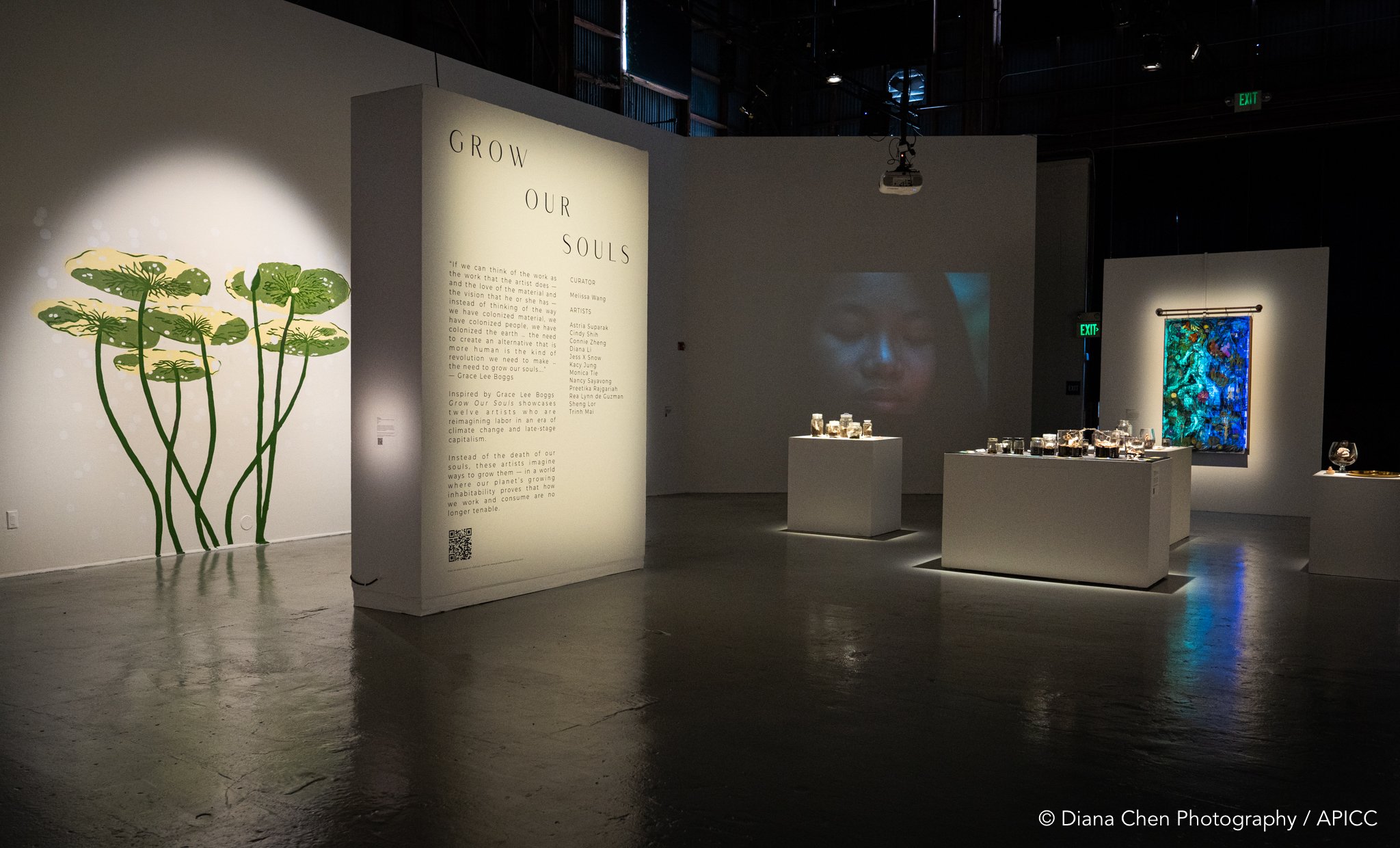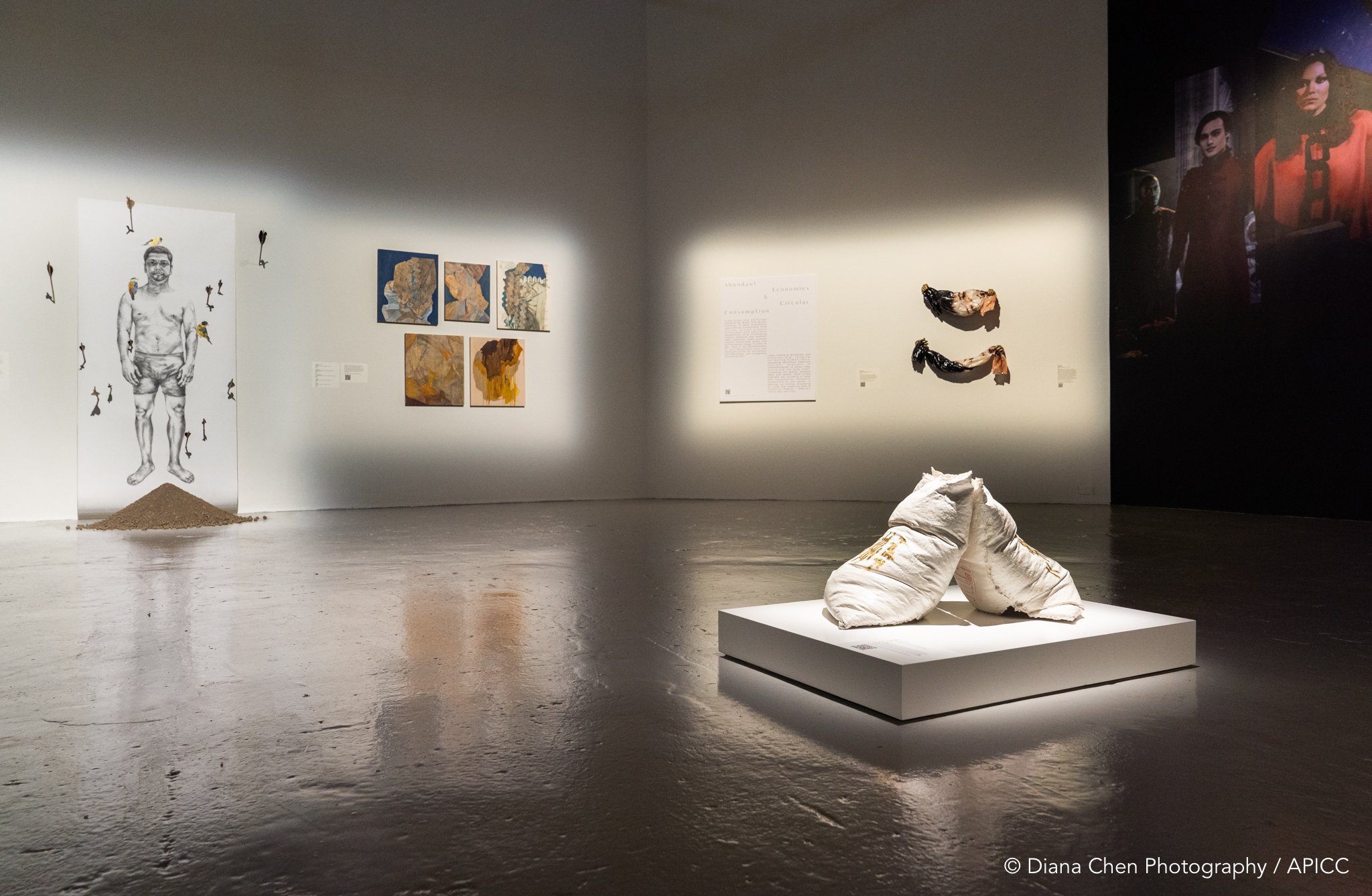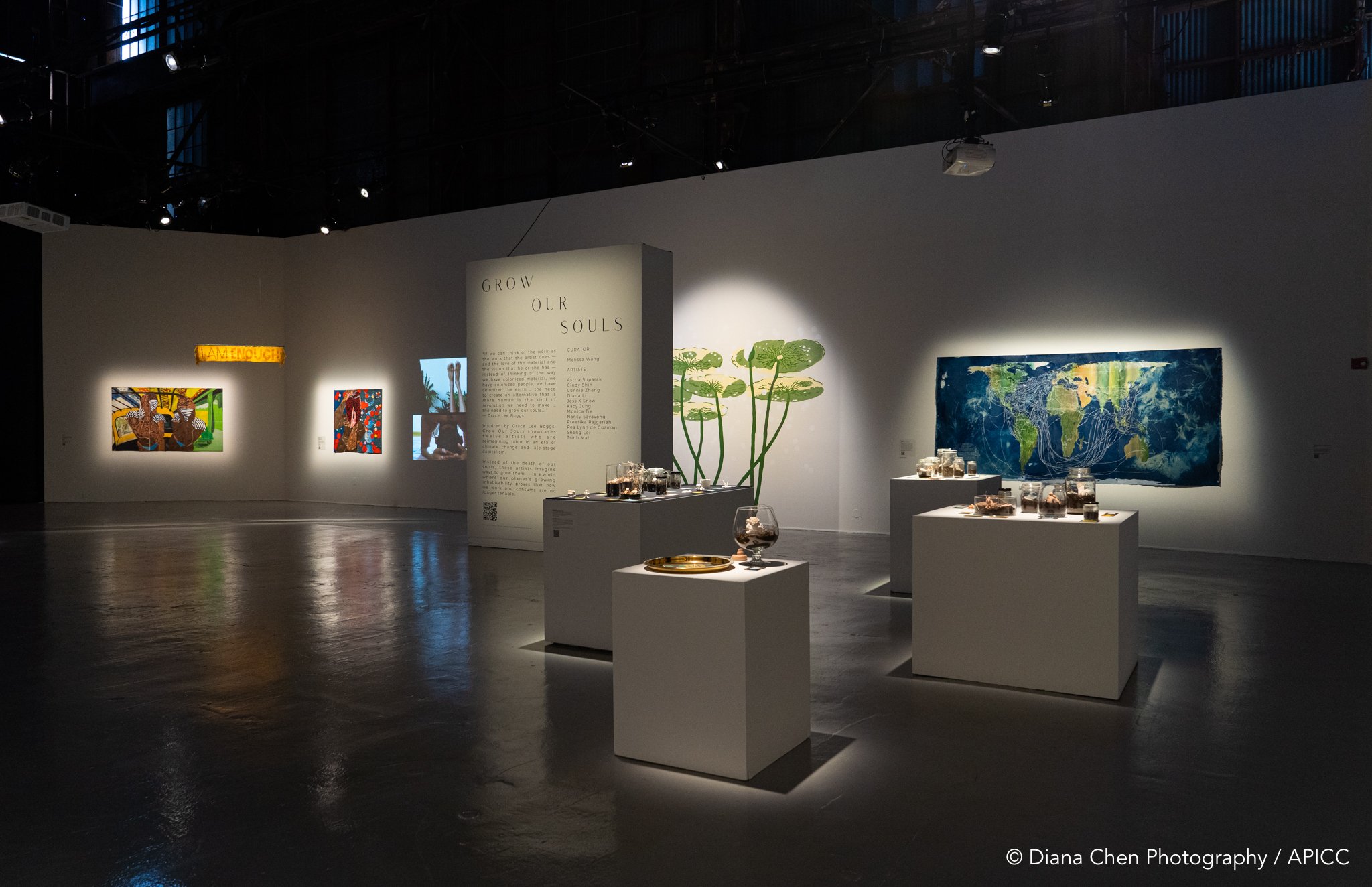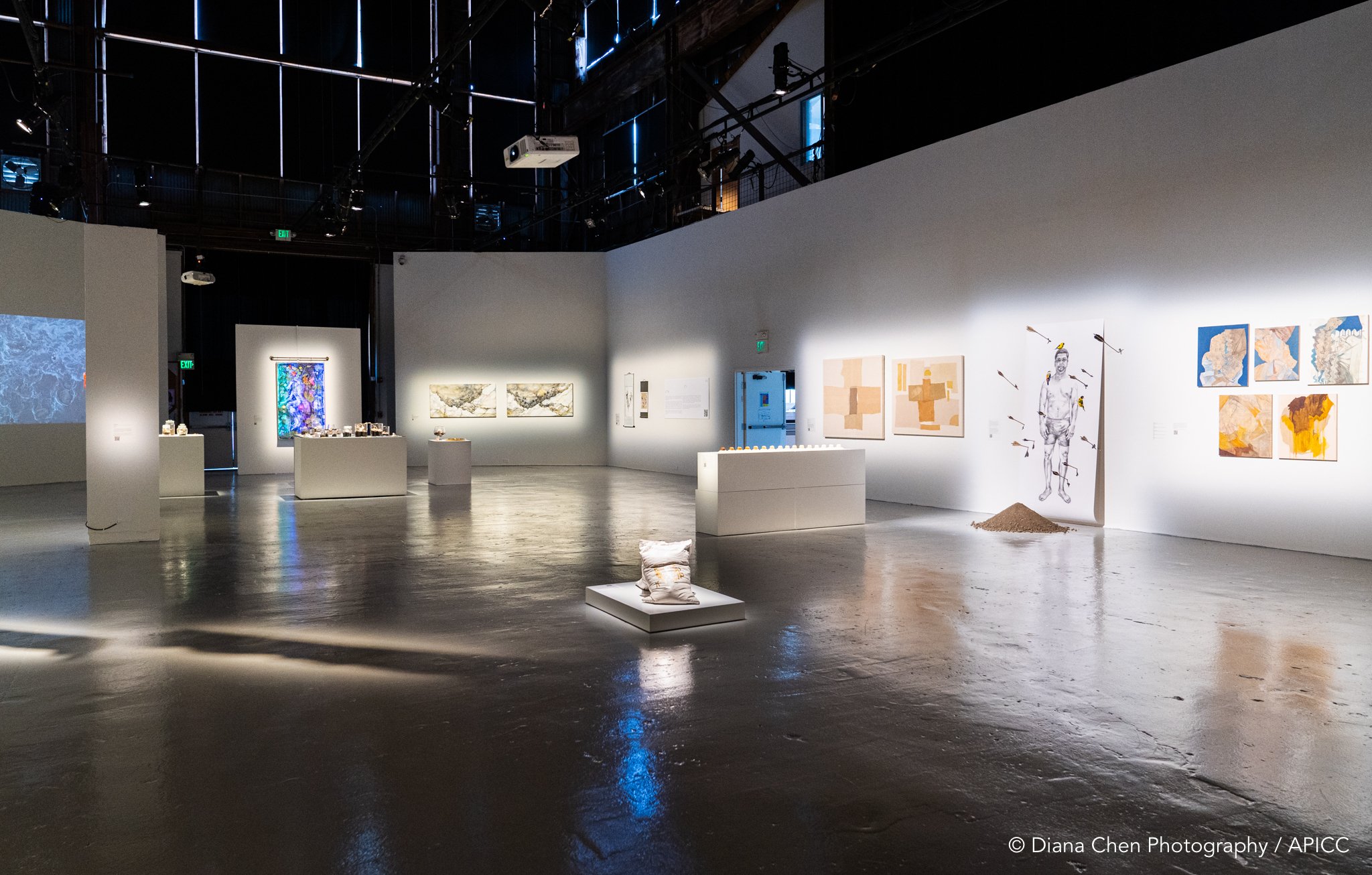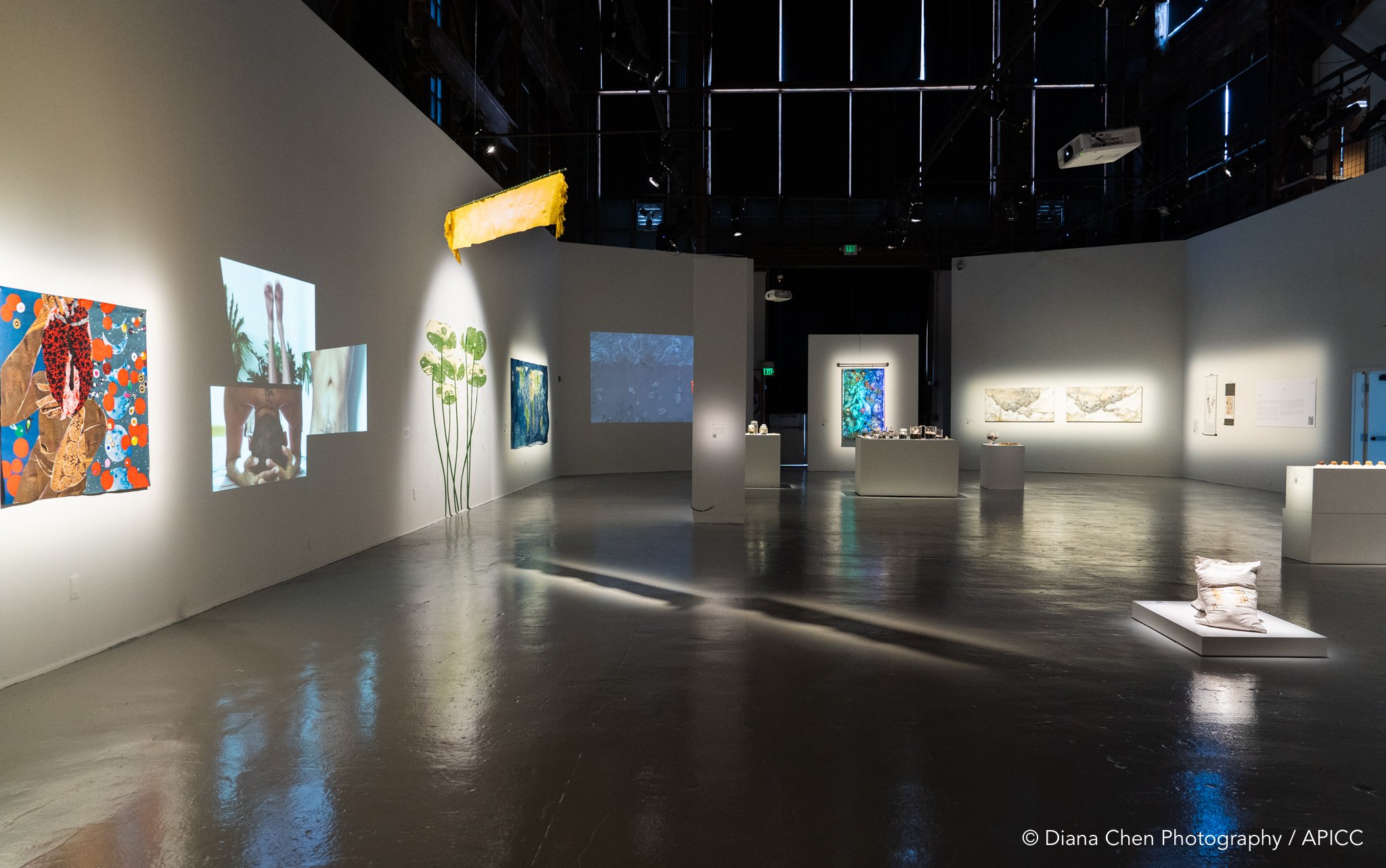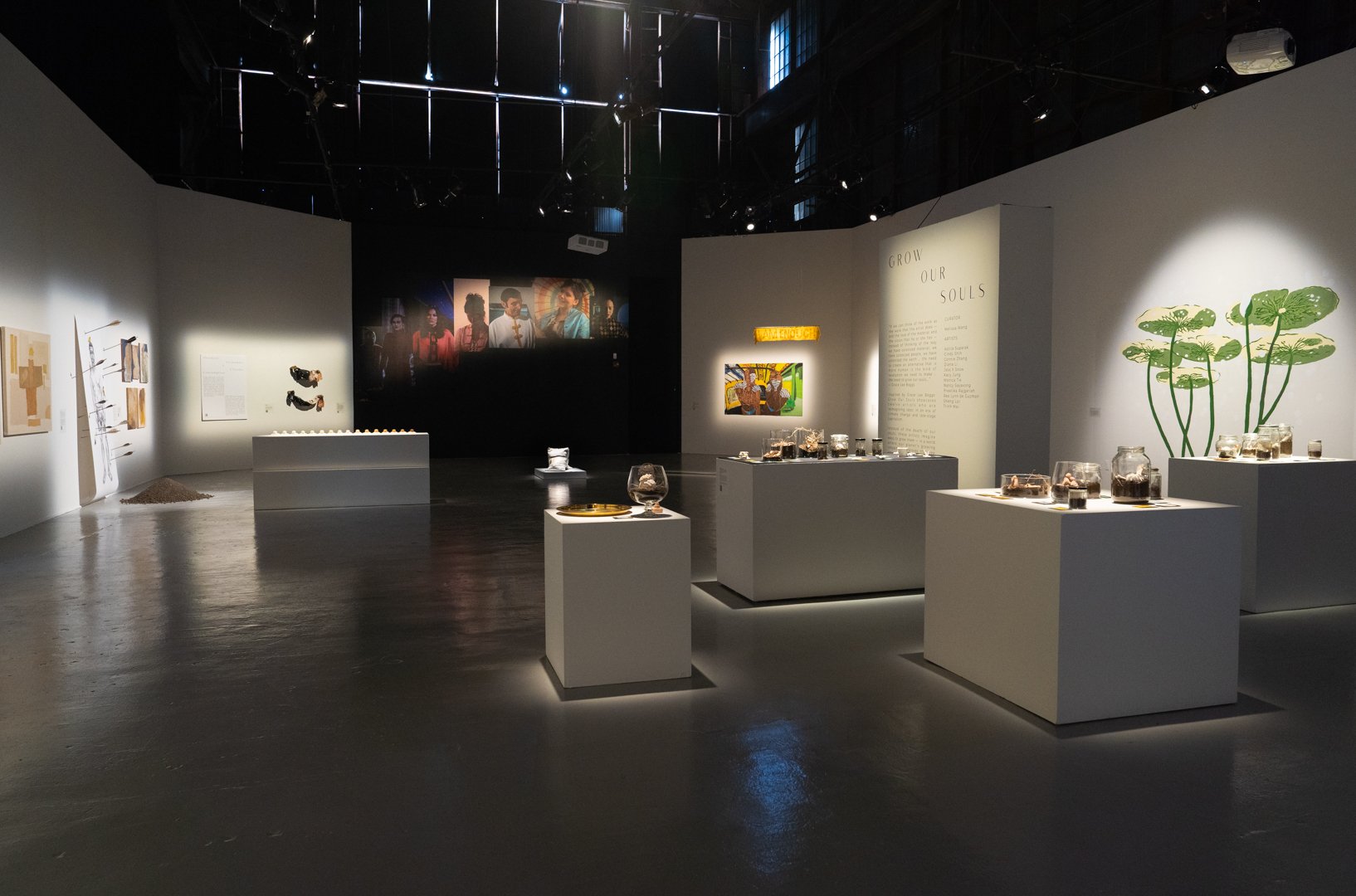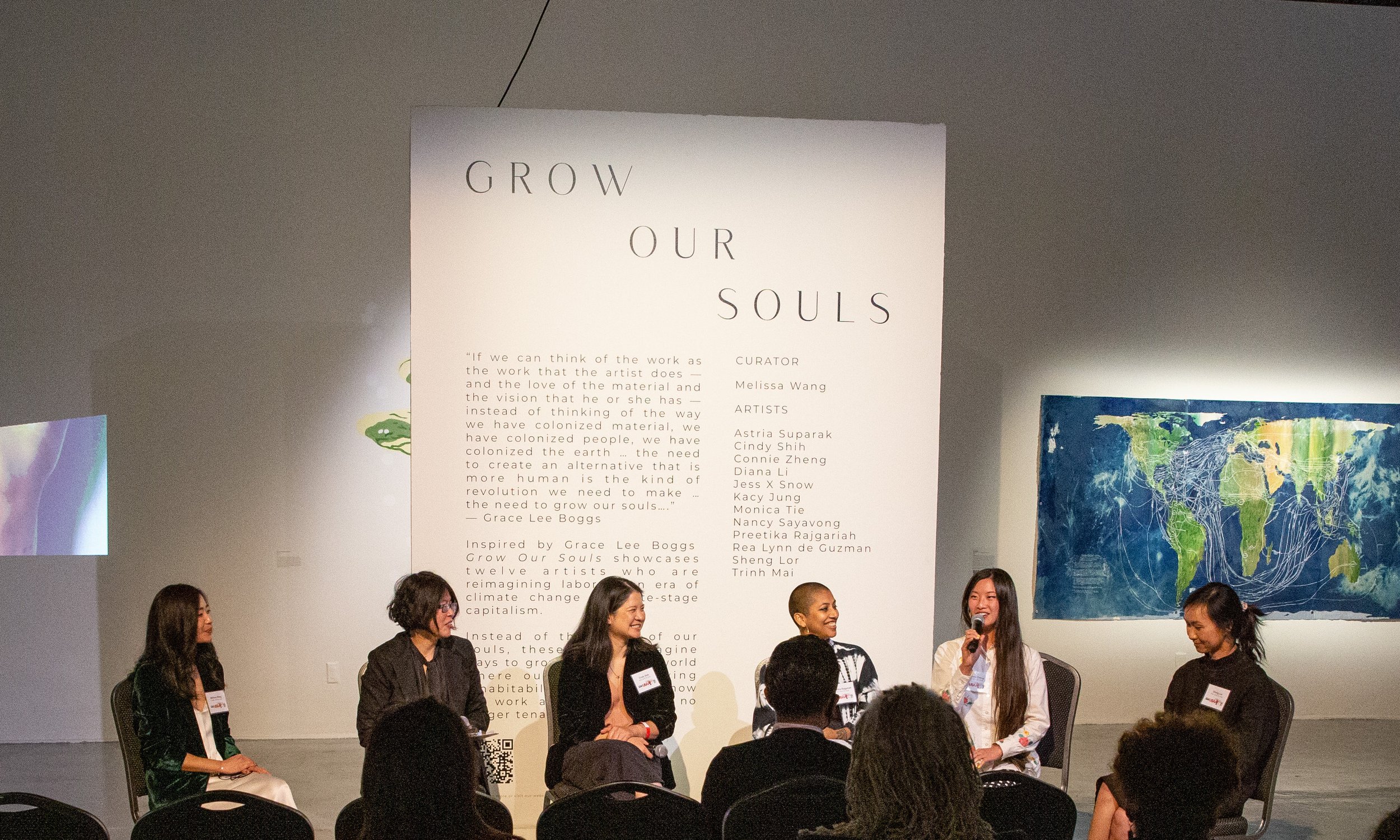I’d like to share some insights around grant-writing based off the feedback I received from the California Arts Council last year, as well as my experience reviewing grants for two different panels this year: Arts in Schools and Arts Administrators.
Grant-Writing for a Personal Grant
I really encourage everyone to apply because if I was able to win it, then honestly anyone can.
The grant was so helpful for pushing me to do mixed-media work and pay creatives as equitably as possible. For example, the overall project budget for our 1-day shoot was $1200, with $100 for each model and the rest for a make-up artist, a photographer and assistant, and 20 post-production images.
It also served as additional funds for my show, Grow Our Souls, that I curated earlier this year. That, along with the budget from APICC, enabled us to pay artists $300 for showing, $50-100 for local delivery costs, $300-500 for out-of-state travel and shipping fees and $2000+ for large-scale printing costs.
For a non-commercial gallery, this budget was competitive and better than what I’ve personally been offered by most commercial gallery group shows.
I know some creatives living hand-to-mouth so it was important to prioritize creative expenses. I’m really grateful to APICC for recognizing that and entrusting me to use the budget liberally.
Metrics That Mattered
On my CAC grant, two things stood out:
Community impact (my most metrics-driven section)
Project description, social impact + letter of support
As a reviewer and as a grant recipient, the sections that received the highest ratings integrated quantitative and qualitative data. We all seem to like numbers and facts.
My most metric-driven section was community impact. Four out of five panelists noted that this was exemplary.
In my description of community impact, I talked about the people I served through independent, volunteer-based creative projects, as well as the money I raised for community projects.
In 2020, I founded my own design studio. By providing pay-what-you-can or pro bono design services for artists and womxn-owned small businesses, I aim to elevate underrepresented voices and communities. These ad-hoc projects also enable me to respond to timely crises that cannot be addressed by my time-consuming, large-scale artworks. Projects I have worked on include: launching a new website for Rose Imai, the director of the Native American Academy and providing design and branding guidance to Virtual Gallery Online, an online gallery that aims to provide virtual exhibitions for newly graduated MFA artists experiencing cancelled shows due to the pandemic. In 2020, shortly after the murders of Ahmaud Arbery, George Floyd and Breonna Taylor, I designed social justice art for Kala Art Institute (Berkeley, CA) and Local Language Art Gallery (Oakland, CA), which raised funds for various Black Lives Matter movements and the Equal Justice Initiative. In late 2020, I co-led an art fundraiser that raised almost $11,000 for Asian Americans Against Trump, a grassroots volunteer-led organization that focused on supporting voter movement projects in the Asian-American community. My next projects include Yellow Woman and Labor of Love, which are both projects that respond to the rise in anti-Asian violence since the start of the pandemic.
I mentioned social justice initiatives, like this poster illustration that raised funds for the Equal Justice Initiative. Note: Chinese text provided by artist Kacy Jung.
My project description and social impact (what organizations I worked with at the time) were buttressed by my letter of recommendation from Michelle Mansour. Three out of five panelists noted that these were exemplary.
In light of the Atlanta mass shooting that took eight lives, including six women of Asian descent, I am creating new work that responds to the incident, as well as curating my second art show titled Labor of Love that highlights womxn artists of Asian descent.
Yellow Woman will be another interactive art photoshoot with the same team as Echo’s Garden that envisions alternate visual representations of Asiatic femininity. Inspired by Anne Cheng’s seminal text, Ornamentalism, the project aims to depict Asiatic femininity as a performance akin to storytelling. Textile artworks, made of deconstructed traditional cultural garments like the chipao or krama, will be interacted with by two models exploring storytelling as a subversive practice, rooted in the experiences of those who survived the WWII Japanese invasion or the Khmer Rouge, to the ancient myth of Scherezade. The fellowship will support project fees, including but not limited to: modeling, makeup/hair, photography, post-editing production and creative direction.
Labor of Love will focus on how love, resiliency, kinship and care for the community are performed, reclaimed or manifested in labor-intensive artworks. Nine Californian artists - including Cindy Shih, Diana Li, Kacy Jung, Palija Shrestha, Zhang Mengjiao, Rea Lynn de Guzman, Trinh Mai, Kim Arteche and Monica Mody - have committed to this project. We are partnering with the Asian American Women Artists Association (AAWAA) and We Da Pepo (transnational artists collective). The fellowship will enable me to continue curation, gain more community partnerships and source for safe, equitable and inclusive spaces and opportunities to host this show in and beyond the Bay Area. We hope to share our stories with the rest of the world during a time of heightened anti-Asian violence, as these incidents are not isolated to California.~
I am a studio artist at Root Division (RD), where I volunteer for our 20-member arts organization impacting thousands of visitors. I provide image and video documentation for shows, including Root Division’s 2020 Art Auction, which raised over $100,000 for after school youth-led programs. During process and policy meetings, I have contributed suggestions for more diversity, equity and inclusivity - from asking for diversity metrics to community-driven content moderation practices - based on my experience as a former diversity lead for a 40,000 person company. Recently, I co-curated a virtual exhibition featuring five RD artists with a former Exhibitions Fellow. A number of RD artists have also committed to be in the show (mentioned in the previous section): Labor of Love.
I am also a member of the Asian-American Women Artists Association (AAWAA) where I have presented work as well as attended critique sessions; the managing director, Diana Li, is one of the artists who has committed to Labor of Love and is our community partner for AAWAA.
It was important that our descriptions of both my personal practice and contributions to DEI were aligned - but Michelle went even further by providing a thoughtful exploration of my work that helped clarify its possible impact.
Personally, I felt this really helped the application, as my personal narrative scored the weakest.
Photo and video documentation at Root Division, including of my own work, was a lot of fun. I even did videos where my hubby had to film me showing off auction items for our virtual auction one year. It was so embarrassing, but all for a good cause!
I honestly have weird psychic blocks around talking about my work and what I hope to accomplish. That’s something I’m actively working on by rewriting my statements, getting them reviewed by both artists and creative professionals, and finally by working as a grant reviewer.
I’m almost embarrassed to share this, but my personal narrative was a hot mess. Three out of five panelists said one of the following:
The narrative would have benefited from further detail regarding the artist’s medium or practice..
The narrative would have benefited from further detail regarding the artist’s challenges and/or accomplishments..
Now, I cringe reviewing this, because it seems like I’m rambling on and on.
I grew up in San Pedro, California, an industrial wasteland where ecological toxicity permeated lower income communities. Early lived experiences of scarcity, including access to nature and natural resources, taught me that social and ecological issues are interconnected. My experiences in other fields have strengthened the philosophies of my art-making practice.
I am self-taught, with a B.A. in Literature/Writing from University of California, San Diego and a M.A. in Literature from University of California, Davis. In graduate school, I researched speculative feminism, a genre that explores prescient responses to environmental issues like climate change. I segued into tech, which I (still) believe is an industry that can solve our greatest global challenges. However, as a former designer at some of the largest tech companies in the world, I encountered challenges designing for human users, let alone other forms of sentience. In late 2019, I quit tech to pursue art-making as a way to wed my beliefs with my practice. Thus, I am an interdisciplinary artist, leveraging abstraction and speculative feminism to fuel my mission of inspiring social and ecological liberation through the arts.
From 2018 to 2020, I explored life stories of the cosmos in my series, We Are Volcanoes and The Word for World is Forest. In response to Ursula K. Le Guin’s critique of Western expansion as full of killer stories, I read works by Robin Kimmerer, Anne Tsing and Donna Haraway, aiming to develop an alternate visual phenomenology that sees the sublime in nature. Throughout the years, my works explored aspects of human exceptionalism - the hierarchical valuation of human lives over others - that enabled the global pandemic and the larger issue of climate change. These works have been shown nationally in exhibitions that highlighted social and ecological justice, including Woman Made Gallery in Chicago, IL; Torrance Art Museum in Torrance, CA; and de Young Museum in San Francisco, CA.
In 2021, as corporate ventures like SpaceX and BlueHorizon aim to privatize space, I wonder if we learned anything from 2020. My solo installation, Without the stars, there is no us, takes a turn toward ancient orders: what Joy Harjo calls “cosmic consciousness.” What is the eternal form or soul - and how does it come into being? Will an awareness of our connection to the cosmos enable us to be less “killers” and more invested in life? Using color, shape, light and mark to represent the matter that make up the observable universe, my process is driven by the energy of these pressing questions.
While painting enables me to envision a visual language in conversation with my material and spiritual concerns, installation is an experimental and collaborative practice that allows me to engage with the community. In the summer of 2020, I created Echo’s Garden, an interactive art photoshoot with local activists and creatives in the aftermath of George Floyd’s murder. I drew inspiration from Gayatri Spivak’s critique of the absence of Echo from myths of Narcissus - and how reclamation of the subaltern subjectivity is not enough. Womxn of color, as a term that arises out of otherness and lack, was expanded to consider the feminine divine: a consciousness of mythic proportions. This project was featured in Rock Paper Scissor (RPS) Collective’s juried exhibition,Towards Justice, on “visionary solutions to a broken system.”
Echo’s Garden led me to establish my own design studio, which offers art direction and design services for artists and women-owned businesses. Design is a subset of my art-making practice that enables me to respond to urgent or timely concerns. See the next few sections for how this fellowship will support new work and an art show proposal that focuses on uplifting one community I support: womxn of Asian or Asian-American descent.
My path to an arts career has been a learning journey towards manifesting the change that I wish to see the world. Thus, my long-term aspirations for both my artistic efforts and projects are to amplify untold or diverse stories and reduce social and economic conditions barring underrepresented artists from recognition and reward in the visual arts. Through my efforts, I hope to inspire ways of living and being with respect to the world.
I don’t have any examples of exemplary personal narratives, so let me know if you come across any!
Examples
Honestly, I’m also not sure what I was thinking when I chose some of these images, especially the painting (maybe it was my newest work at the time)?
Ttwo out of the five panelists thought the examples were exemplary, including an excerpt I submitted from my interview with Chanell Stone for my Root Division installation. Three had no comment.
Grant Reviewing
When I signed up to review 40+ grants for $300, my husband remarked that I was really just working for free. I totally agreed, but I wanted to review the grants, as there seemed to be few Asians in the reviewer pool (only I and one other panelist voluntarily introduced ourselves).
So I was not surprised that during the 1-hour training session, we had a brief discussion of unconscious bias in which one of the reviewers commented “I married an Asian [so I am] aware of accents.…” Yet, I was so surprised no one said anything! Isn’t this the perfect example of unconscious bias (someone monolithizing hundreds of ethnicities while conflating cultural consciousness with an individuated experience, not to mention a micro-aggression)?
In my survey, I gave feedback about this to the CAC team, including recommendations on improvements (only because they asked for them). FYI, at Meta and Google, it was fairly understood that it’s not the role of women of color or minorities to call these out, as its additional (unpaid) labor that we perform on top of experiencing othering/racism. I also want to point out that this is the case because (at least superficially) DEI is recognized as a right, not a perk, in these major companies.
Despite that minor encounter, the experience was interesting and educational. It’s super humbling to see what other organizations are working on, as there are some brilliant and amazing initiatives occurring throughout California. Although reviewing 40+ applications was a slog at times, taking up anywhere from 15 min to 1+ hour, I enjoyed it as seeing programs designed to make kids happy and mitigate real-world problems is super inspiring. Plus, I was a beneficiary of free California arts programs and classes, so I understand how incredibly valuable they can be to an artist.
What Stood Out
As a grant reviewer, the projects I liked best were not necessarily the most inventive, innovative or even technically strong ones. They were the ones that were written clearly and directly about:
What they did or wanted to do - and how they would achieve it
How it would or have already impacted folks by taking their feedback into consideration.
I’m not sharing any actual application content, but GetLit or Geffen Playhouse were really great at describing their programs and impact, as well as how they work, partner and serve their communities. Plus, they have AMAZING videos. Some organizations described a dance or performance workshop, but only submitted photos. Examples matter because they help affirm or demonstrate the strength of your proposal!
The Importance of Community Engagement to CAC
For organizations, community engagement is not necessarily measured by just who they partner with but by how they make improvements based off of data. So, for example, if the organization serves a county that is predominantly Black and Brown, it’s not enough to just hire diverse artists but source feedback from the community as to whether the organization makes artists and students feel safe and seen (which is also reflective of the efforts to which they assess whether their mission interests or objectives are actualized). This was built into the scoring criteria, so it was good to see that CAC valued these efforts.
Some organizations had data from several years back, gauging not just attendance numbers but social and cognitive behaviors, like learner confidence in their new skills. There’s something called Kirkpatrick’s Levels of Evaluation that are widely used in the training industry to help measure beyond “butts in seats” to ensure learners actually retain information. I’m not sure what methodologies the organizations were using, but they seemed to be measuring L2 (confidence levels) and L3 (teaching them a dance, and recording them performing it) vs just sharing how many people attended their classes.
This is not something individual artists seem to be expected to do (for example, how would you measure paintings or site-specific works?), although, when possible I think it’s a sign of working with the community when you signify you’ve not only sourced feedback, but acted on it in ways that aspire to make your services, experiences or works more inclusive or accessible.
Plus, it’s a great way to gather metrics on whether what you’re doing is making a quantifiable impact.
How I Gather Data or Metrics
For example, after my artist workshops at Facebook, I sent surveys asking for feedback. However, no one responded because it was right before holiday break :*(.
For commissions or projects, I have iterative sessions or project check-ins that incorporate client feedback. If they liked the work, I ask to share their (hopefully) glowing reviews or quotes on my website or marketing materials.
If I’m working with an organization, I ask how many visitors viewed or interacted with an asset (if it’s digital) or visited the exhibition (if it’s in-person). For the Grow Our Souls exhibition website, my web designers conducted user testing on desktop and mobile before the site launched. This was to ensure visitors could find what they were looking for and minimize bounce rate. The website objective was reach; over 900+ unique visitors have visited the website since we launched in April 2022.
Due to my health, I wasn’t able to be in the physical exhibition much, but when I did, I went up to random visitors and asked them about their experience, including what would improve it. Quantitative data was about 200+ visitors and qualitative data included visitor comments like, “I never knew there were so many Asian women artists in the Bay Area [and now I do]” to “[This was] gorgeous and uplifting.”
One fun quantitative data point was that Astria’s installation was included in her submission for the Artadia award in San Francisco, which she won! I think the hope is that exhibitions always engender more opportunities, and this was one that combined both recognition and financing.






